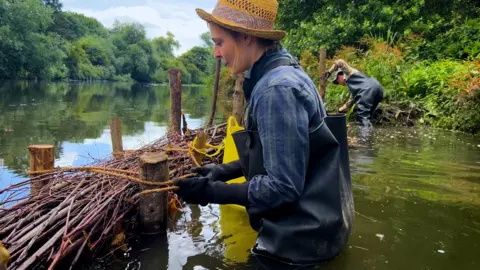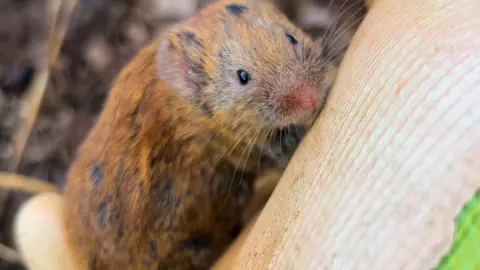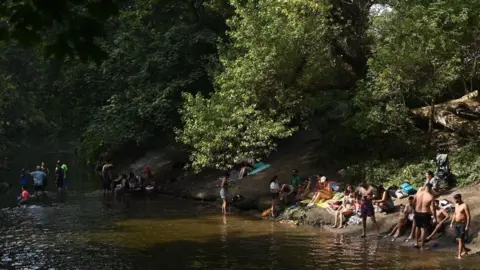Rewilding sees animals rebound in Hackney Marshes
 Ian Phillips
Ian PhillipsEnvironmental groups have claimed success after bringing local wildlife back to Hackney Marshes in east London following the erosion of habitats in recent years.
Kestrels, weasels, shrews, wood mice and other small mammals had been slowly disappearing from around the River Lea until hundreds of volunteers began rebuilding their ecosystems with piles of logs, artificial food caches and by selectively cutting trees, known as coppicing.
Ian Phillips, an ecologist who has helped lead the river restoration project over three years, said it "feels like it happened almost overnight".
"It was just absolutely amazing to see everything fall into place."
With funding from Hackney Council, the Environment Agency and the Mayor of London, the biodiversity scheme was undertaken by groups such as ReNature London, Wildlife Gardeners of Haggerston (WGH) and Save Lea Marshes.
Mr Phillips said restoring the mammals' natural surroundings had become urgent after the disappearance of wood mice caused a domino effect of weasels leaving the habitation, in turn impacting the local kestrel population.
"It's like a classic sort of Jenga – if you pull the wrong piece out of the local ecosystem, everything collapses," he said.
"Three years ago, we realised we were at an absolute crunch point. So we took it upon ourselves to do something."
The ecologist said the reason for the exodus of local wildlife were larger numbers of visitors trampling over the terrain, but also house-boaters taking logs from the area to use for firewood – alongside the so-called 'Hackney Beach' river parties during the pandemic.
 Ian Phillips
Ian PhillipsWhile these gatherings made headlines, the ensuing loud noise and log burning caused great disturbance to local species, prompting kingfishers and little owls to abandon their nests, Mr Phillips added.
A spike in dog ownership during lockdown also saw a rising threat to the marshes' mammals.
"It became quite grim for the wildlife. A couple of days ago we counted someone with 16 dogs, and when you've got probably upwards of 3,000 dogs coming through here a day sometimes, there are going to be casualties," Mr Phillips said.
 Getty Images
Getty ImagesGideon Corby, lead ecologist for the Old Lea River Restoration project, said: "In the midst of our biodiversity crisis, this project shows what can be done with local knowledge and dedication in partnership with the council."
The rewilders said they hope to expand their efforts across the borough into Millfields Park and London Fields.
They are also actively training council staff to help them recover species in the wider area.
Meanwhile, Hackney Council has given them the green light to introduce other species like common lizards and slow worms into the Marshes.
Listen to the best of BBC Radio London on Sounds and follow BBC London on Facebook, X and Instagram. Send your story ideas to [email protected]
